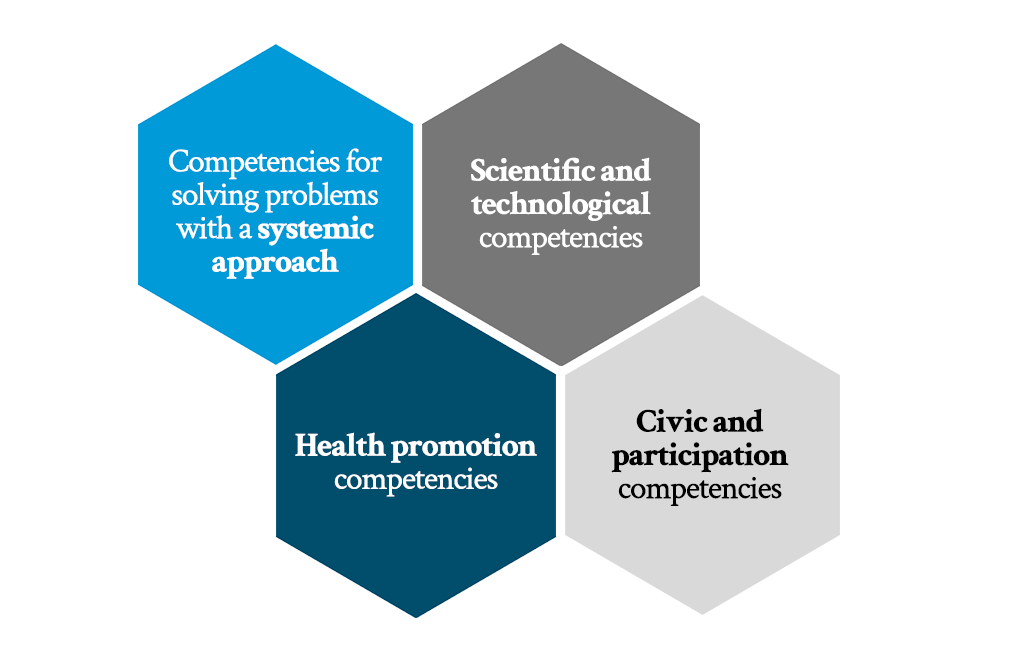Health promotion with citizen science

Solutions for infections and other biomedical challenges investigated by IrsiCaixa will be more effective if they are accompanied by health promotion and prevention interventions. However, the effectiveness of these interventions is often not as high as we would like, and health problems tend to persist or even worsen over time. This is partly because these problems are complex.
To address this complexity, the IrsiCaixa Health Living Lab designs citizen science programs that follow participatory and systemic approaches, both in their design and in their implementation.
During the design process:
-
The objectives are defined that each classroom must take into account in order to plan and implement, in a participatory way, a personalized and meaningful intervention. These objectives resemble the Sustainable Development Goals, as they were also designed using systemic approaches.
This figure shows an example of the objectives of one of IrsiCaixa’s interventions (InfAction, for the prevention of infectious diseases in classrooms).
- A repository of activities aimed at the different objectives is developed.
- A Teaching Guide is designed so that each classroom can engage in citizen science and implement personalized campaigns to improve its health promotion.
Why apply citizen science to health promotion programs?
Citizen science offers students the opportunity to apply innovative participatory research processes to investigate, within their educational and family environment, their needs as well as the problems and opportunities for maintaining healthy habits.
Based on the results of this research, students are invited to design and implement personalized educational and/or informational campaigns, with the aim of addressing these issues in an active and meaningful way.
Students as agents of change
Students learn to apply the scientific method in a participatory way to help address health challenges with and for their local community. In this way, knowledge and learning are developed both in the classroom and in the community environment, and students become both co-researchers and agents of change.

Students develop transversal competencies.
Why are our health promotion programs innovative?
Given that health problems are caused by a wide range of factors and social actors, there is a need to experiment with participatory and systemic processes to design and pilot initiatives capable of addressing this complexity. For this reason, it is proposed to experiment with an intervention model that goes beyond traditional health education activities, which, in isolation, have been shown to have limited impact.
IrsiCaixa’s programs are characterized as:
- Comprehensive: students carry out a diagnosis through participatory research with a systemic analysis that allows them to identify problems, opportunities, and needs related to health challenges from a holistic perspective.
- Personalized: based on the diagnosis, students design an action plan adapted to address the prioritized problems and needs in the classroom, using a repository of activities. This allows them to select the most relevant and urgent interventions at any given moment.
- Collaborative: students take ownership to proactively promote health and prevention, with the support of teachers and in collaboration with families and health professionals. This approach ensures continuity of interventions over time through shared leadership between young people and educators. At the same time, it is implemented in a network with other organizations dedicated to health promotion and prevention, which contribute resources to the program repositories.
- Decentralized: implementation is autonomous and led by the teaching staff of each educational center, with support from the Living Lab. This model facilitates scalability and sustainability of the program across different regions.
- Transformative innovation: the programs involve various social actors in iterative processes to progressively transform school and community environments. Programs are evaluated annually to implement ongoing improvements.

Who are they aimed at?
Students in upper primary, secondary education (ESO), high school (Batxillerat), and vocational training (FP).
Do you want to do citizen science and health promotion in your classroom?
Three distinct programs are offered:

They learn about West Nile Virus and vaccines, investigate the factors that influence the decision to get vaccinated, and promote activities to support the educational community in making informed vaccination decisions.
Program materials:
![]() PRIMARY EDUCATIONAL GUIDE
PRIMARY EDUCATIONAL GUIDE
![]() PRIMARY REPOSITORY
PRIMARY REPOSITORY

They learn how infectious agents are transmitted and investigate which factors influence their prevention. They design and implement a personalized action plan to prevent transmission in their environment.
Program materials:
![]() SECONDARY EDUCATIONAL GUIDE
SECONDARY EDUCATIONAL GUIDE
![]() PRIMARY REPOSITORY
PRIMARY REPOSITORY
![]() SECONDARY REPOSITORY
SECONDARY REPOSITORY

They learn about mental health and investigate the factors that influence it. They design and implement personalized actions to promote emotional well-being within their group and the educational community.
Program materials:
![]() SECONDARY EDUCATIONAL GUIDE
SECONDARY EDUCATIONAL GUIDE
![]() PRIMARY REPOSITORY
PRIMARY REPOSITORY
![]() SECONDARY REPOSITORY
SECONDARY REPOSITORY
How are they implemented?
Program phases:
- Teacher training (online 2h). Practical workshop to learn about the programs and understand how to apply the teaching guide.
- Classroom implementation (5 sessions of 50 minutes + personalized activities).
-
Presentation of a challenge by project scientists.
-
Exploration of the topic and implementation of citizen science with a systemic approach to analyze the factors that determine prevention and health promotion across different challenges.
-
Prioritization, design, implementation, and evaluation of educational and/or informational actions with and for the educational community and its social environment.
-
- Teacher follow-up meeting (optional online session, 30 minutes). Space for support and clarification with the educational and scientific team of LWNVIVAT.
- Final congress (online). Meeting of participating educational centers where students give presentations and interact with the scientific community.
- Evaluation (online questionnaire(s)). Assessing the acquisition of knowledge, scientific and civic competencies, and the implementation process.
Participation so far:
To date, more than 3,700 students and over 150 teachers from 68 educational centers have participated in the citizen science programs.
How to participate:
Interested educational centers can contact the Living Lab for Health at IrsiCaixa (livinglab@irsicaixa.es).
Who coordinates the programs:
The health prevention and promotion programs are coordinated by the Living Lab for Health and are currently developed within the framework of the European LWNVIVAT project.
